February 10, 2016

Buying your first home is a terrific investment that will build your wealth over time. But before you dive head first into real estate, it’s important to be aware of the complexities and costs associated with this process, so you’re not caught off-guard.
While the majority of your home will be paid for with a mortgage loan, you’ll also need to save a substantial sum of money for your down payment – a one-time cash payment that you’ll provide at closing. Mortgage lenders require buyers to make down payments because they offer an incentive to keep your home out of foreclosure – otherwise you risk losing that money.
Unfortunately, saving for a down payment so you can buy your first home can feel impossible when a large chunk of your paycheck already goes directly to your expenses, student loan payments, and other debts. But while these factors can impact your ability to save for a down payment, they don’t have to. As long as you’re diligent and strategic, it’s still possible to go from renter to proud homeowner. Here’s how:
Calculate how much house you can afford.
Before you start saving for a down payment, you need to know how much house you can realistically afford. You can start by using an easy mortgage calculator like this one – but don’t stop there. Many new buyers don’t take into account the myriad expenses that come with home ownership, including routine maintenance, property tax, and private mortgage insurance if your down payment is less than 20%. Add those costs onto your existing student loan, wedding, and credit card debt, and your monthly expenses could rapidly become unmanageable.
For example, maintenance is usually about 1% of the home’s value each year. That means if you buy a $400,000 home, you’ll pay a minimum of $4,000 a year on maintenance, which would be about $333 a month. Make sure you’re being realistic about your budget and factoring in all of the costs associated with home ownership, to make sure you don’t end up with more house than you can afford.
Set your down payment savings goal.
Although your down payment can range from 3% to well over 20% of your home’s value depending on your credit history, type of home, and reason for buying, we generally advise new buyers to save a 20% down payment at least. For example, if you hope to buy a $295,000 home, you’d want to save $59,000 for your down payment. This type of larger down payment is recommended because you’re more likely to get approved for a mortgage, qualify for a lower interest rate, and enjoy lower monthly payments. Plus, you won’t need mortgage insurance and you’ll be mortgage-free sooner.
Once you know the size of your down payment, you need to figure out when you want to buy – while making sure you have plenty of time to save. For example, if you want to save $59,000 within five years, you’ll need to put away about $985 each month. If that’s not realistic based on your current income and expenses, adjust your goals accordingly, and aim to buy in seven or eight years instead.
Start budgeting and saving.
If you’re like the vast majority of recent graduates, you’ll need to adjust your budget to make room for an extra $985 a month. We go into detail about setting a budget here, but to get started you’ll want to evaluate your spending and look for areas where you can cut back – like eating out less and clipping coupons to save on groceries. Doing so can save you hundreds of dollars a month, which you can then put towards your down payment.
It’s also a good idea to save (rather than spend!) any unexpected income you receive – like gifts, commission checks, and tax refunds. Doing so can easily add up to a couple thousand dollars a year, which could make you a homeowner much more quickly.
Consider refinancing your student loans to free up extra money.
If you have student debt, a decent portion of your monthly income is likely already earmarked for these payments – rather than your dream of becoming a homeowner. But the good news is, these payments aren’t set in stone. As long as you have good credit, a student loan refinance can reduce your monthly payments – freeing up money to put towards your first home so you can accomplish your down payment savings goal more quickly.
To find out how much money you could save, simply plug your remaining debt and monthly payments into this easy calculator. From there, use a service like LendKey to shop around for the most favorable interest rates and loan terms to find the lender that’s best for you.
Be cautious about borrowing from your 401(k).
Many aspiring homeowners consider borrowing from their employer-sponsored retirement plan, or 401(k), to make their down payment. This type of loan can be appealing for a number of reasons. For starters, it allows you to borrow up to 50% of your account balance, to a maximum of $50,000. While the repayment term is usually five years, it can be extended if you’re buying a home. Plus, a 401(k) loan doesn’t have to be approved by a bank, so you’ll receive the money more quickly, interest rates will be lower, and you’ll pay back your loan through automatic deductions from your bank account.
However, there are drawbacks. If you don’t make a payment within 90 days, your loan money is considered a distribution. That means it’s taxed as income plus a 10% penalty if you’re under 59 ½ years old. And if you’re let go from or leave your job, you must repay the entire loan within 60 days or incur those same penalties. Plus, while the money is in your house and not your retirement plan, it isn’t earning anything. The interest payments aren’t tax-deductible and you pay yourself back with after-tax earnings, which means your annual taxable income isn’t lowered like it is with regular 401(k) contributions.
So – should you borrow from your 401(k) to make your down payment? In most cases, we vote no. It’s generally not a great idea to take out money from your retirement plan for any reason – even if it is to buy a house. However, if you’re using the loan for a short-term fix, and you know you can pay it back quickly (for example in bonuses you’ll earn over the next year), then it may be a smart move. But in any other case, we recommend keeping your retirement savings safe and following the other tips in this article to save for your down payment. Not only is it the safer and smarter route – but you’ll thank yourself when retirement time rolls around.
Please note that the information provided on this website is provided on a general basis and may not apply to your own specific individual needs, goals, financial position, experience, etc. LendKey does not guarantee that the information provided on any third-party website that LendKey offers a hyperlink to is up-to-date and accurate at the time you access it, and LendKey does not guarantee that information provided on such external websites (and this website) is best-suited for your particular circumstances. Therefore, you may want to consult with an expert (financial adviser, school financial aid office, etc.) before making financial decisions that may be discussed on this website.



